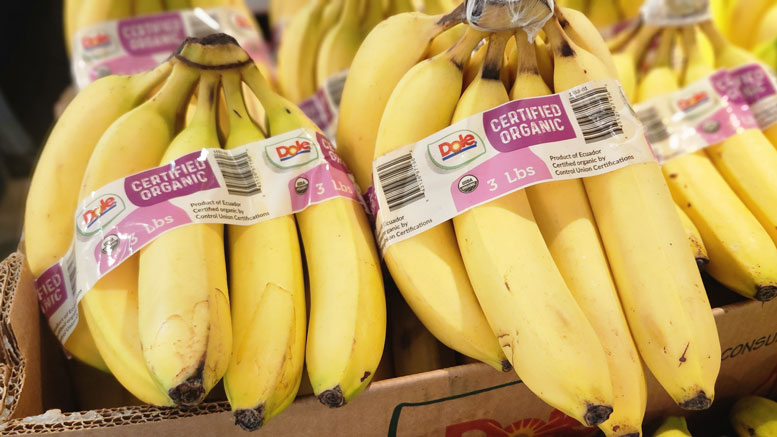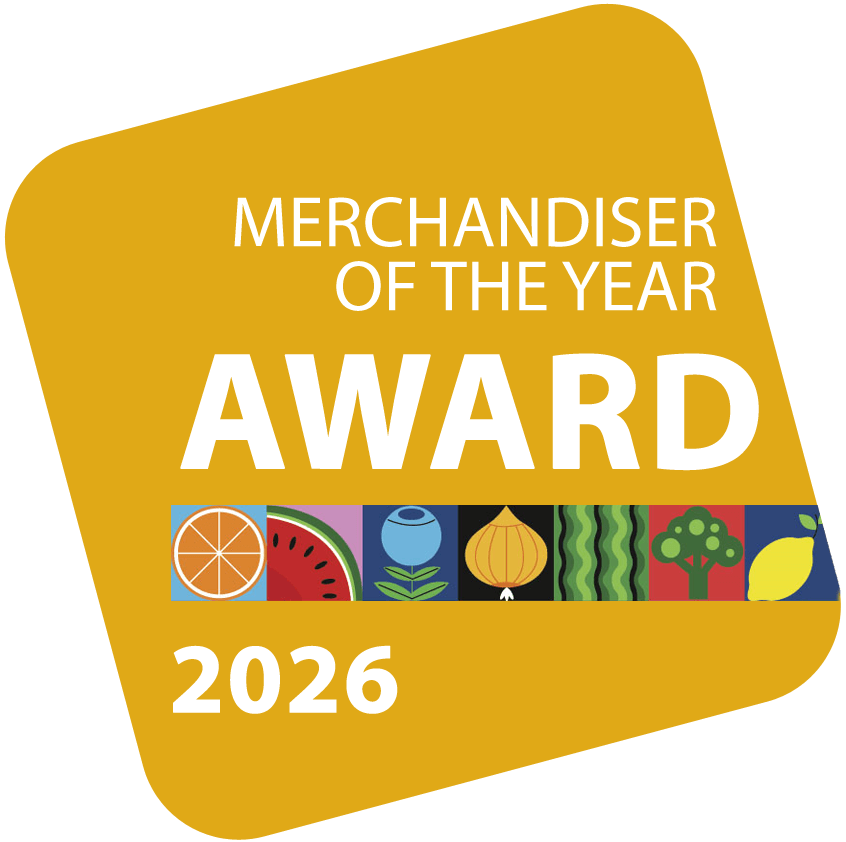There’s Gold in Those Organic Bananas
October 2, 2024 | 8 min to read
Despite overcoming inflationary pressures, organic bananas are thriving, with a 4.3% increase in sales to $423 million in 2023. The Organic Trade Association reports they are the top organic import by value at $360.5 million. Retailers are advised to cater to growing consumer demand for organic options, emphasizing ripe displays and minimal plastic packaging. Both Organics Unlimited and Dole Food Company highlight the importance of recognizing the true costs of bananas to ensure sustainable practices continue.

PRODUCE BUSINESS/AIMEE TENZEK PHOTO
How to make the most of the boom in organic bananas.
Consumers have faced significant inflationary pressures over recent years, affecting purchasing decisions at retail, but organic bananas have been bucking the trend.
According to the Washington, D.C.-based Organic Trade Association (OTA), organic bananas saw stronger growth in sales and volume in 2023 than conventional bananas, with the dollar amount of fruit sold in U.S. in 2023 up 4.3% on the previous year to $423 million.
This assessment echoes U.S. Department of Agriculture (USDA) data on the sales value of produce imports between July 2023-June 2024, which found that organic bananas were the highest organic import by value at $360.5 million, up 10% from the same period 12 months before.
As a pioneer in organic banana imports from Mexico since the mid-1970s, San Diego, CA-headquartered Organics Unlimited has long experience in the market, and sound reasons for optimism, according to General Manager Daniella Velázquez de León.
“It is imperative that the market recognize the true cost of bananas, otherwise there will come a day where sustainable, ethical bananas will no longer be an option for consumers.”
— Daniella Velázquez de León, Organics Unlimited, San Diego, CA
Despite market and inflationary pressures, Velázquez de León says organic produce has continued to grow its share of overall produce sales year-over-year, with the organic banana segment seeing stronger growth in 2023 than its conventional counterparts.
“We expect this trend to continue, as today’s consumer is more health-conscious and environmentally aware,” she says.
Similarly, Bil Goldfield, director of corporate communications for the Dole Food Company in Charlotte, NC, says Dole’s organic banana production is growing, echoing a market that is continuing to expand in both volume and dollar sales.
Organic bananas have been a flagship part of Dole’s organic business for more than 25 years. The company produces organic bananas in its own farms, and sources from independent organic growers, primarily in Colombia and Ecuador, with additional sourcing in Peru and Mexico.
Now the largest grower and distributor of premium organic bananas in the U.S., Goldfield says Dole’s organic production has led to learnings that have positively impacted conventional production techniques, while its sourcing network has allowed the company to keep up with increasing demand over recent years.
DEFINING SPACE TO SALES
According to Goldfield, the organic segment’s increasing share of Dole’s overall banana business is evident in the share of the produce department footprint devoted to organic bananas and other organic fruits and vegetables.
Demand has reached such a level that Velázquez de León says it is now not uncommon for organic-focused retailers to have transitioned to carrying organic-only products, including bananas.
“As consumers grow to expect organic as an option in all retail spaces, we recommend having space for each with clearly differentiated signage,” she suggests.
Ripening is another important consideration when it comes to on-shelf displays, and Velázquez de León recommends stocking stage 3-4 bananas that “already have some color to them.”
However, she also recommends offering a range of options that allow customers to shop based on their preference, whether they’re ready to snack right away or need the bunch to last a week.
Gustavo Carranza, senior product manager (Bananas N.A.) for Coral Gables, FL-headquartered Fresh Del Monte Produce, says — as with conventional varieties — consumers want their organic bananas to be ripe and ready to enjoy at the time of purchase, with minimal green and no spotting.
“Most retailers opt for stage 3 (out of the seven stages of bananas ripening) at delivery, to allow time for retail sales at peak ripeness,” he says.

DEAN BARNES PHOTO
Goldfield makes similar recommendations, citing a survey conducted by Dole in March 2024 of 2,000 Americans, as part of the company’s 125th “Banana-versary,” which found that half of all banana consumers look for perfectly yellow fruit with no green or brown spots.
“Each retailer has their preferred color level when merchandising based on their own shoppers’ habits,” says Goldfield. “Although offering a broad color range is optimal to increase sales — a cluster for immediate use and one for days later — organic shoppers generally purchase slightly greener fruit. Stage 3, a 50/50 ratio of green to yellow is often found at the display.”
BAGGED V. UNBAGGED
There is some evidence of regional differences, especially when it comes to bagged versus loose.
Goldfield says retailers in eastern parts of the U.S. generally merchandise organic bananas bagged, while unbagged is more prevalent in the west, although he advises opting for the latter option.
“One of the major benefits and value propositions of organic produce to consumers is the environmental health and sustainability aspect. We advise retailers to sell organics without bagging, if possible, to reinforce that connection,” he says.
Likewise, Velázquez de León at Organics Unlimited says bagged bananas are a turnoff for organic consumers. “The organic customer wants to reduce plastic waste, not increase it by adding a bag to fresh produce that already has nature-made packaging in the form of a beautiful yellow peel,” she says.
“When customers want to differentiate between conventional and organic packaging or discourage the splitting of bunches at retail, we recommend banded bananas instead.”
Fresh Del Monte’s Carranza also signals a preference for banded rather than bagged. “In general, 98% of Del Monte organic bananas are banded, and only 2% are bagged. This figure is fairly consistent across North American regions.”
Bananas are among the most popular fresh fruits in North American supermarkets and consistently rank high in frequency of purchase for all demographics, Carranza continues. “Fresh Del Monte leverages the broad appeal of the banana in both conventional and organic varieties with marketing campaigns, initiatives and retailer programs that help boost incremental banana sales,” he adds.
SETTING THE RIGHT PRICE
While retailers ultimately set pricing, Carranza says Del Monte organic bananas are considered a premium product because the organic certification ensures they meet stringent standards for environmental sustainability and are grown using organic farming methods.
“Organic bananas are the preferred choice by many health-conscious consumers, and the double-digit growth of this category in recent years seems to indicate that price is not a barrier for many consumers,” he says.
Velázquez de León agrees there is effectively a premium for organic bananas due to the higher cost of organic farming practices and certification. However, she says the price gap between conventional and organic bananas has narrowed over time.

PRODUCE BUSINESS/SUSAN CROWELL PHOTO
“While some may say it’s because the supply chain has become more efficient, the reality is that, just as with conventional bananas, there has been immense market pressure to maintain artificially low prices since bananas are known for being a cheap produce item,” she says.
“It is imperative that the market recognize the true cost of bananas, otherwise there will come a day where sustainable, ethical bananas will no longer be an option for consumers.”
Although essentially the same as conventionally grown bananas in quality and shelf life, the applications and handling of organic bananas must follow the guidelines and protocols set forth in the USDA NOP — and these added steps constitute an added expense, says Goldfield.
“Consumers understand organic bananas will generally taste the same as conventional and provide the same attributes they already love about America’s favorite fruit, but have less understanding of the increased costs associated with more hands-on labor and premium growing inputs,” he says.
“Our goal has long been to communicate this premium, traceable to higher growing costs, into tangible consumer environment and societal benefits associated with soil health, enhanced biodiversity, and sustainable agriculture,” he says.
To encourage more organic sales, Goldfield recommends retailers and produce managers ensure the fruit is sourced through a trusted supplier, and displayed with usage suggestions, production information and educational information focused around organic bananas.
Of course, organic is not the only produce label out there, and “fair trade” in particular appears to have some crossover. Rather than being a threat, Velázquez de León believes marketing bananas as “fairly traded” complements the organic subcategory, as both emphasize ethical, sustainable practices.
“The reality is that the banana industry has a dark history. Offering customers fairly traded options gives them the option to support businesses that give back to their workers and communities,” she adds.
• • •
Retailers Should Display Riper Fruit Ripened at a Slower Rate
Thermal Technologies, designer, manufacturer and installer of banana and multi-fruit ripening rooms, markets the TarpLess ripening room system, which is currently used by many North American retailers, including Kroger, Wholefoods, Albertsons and Walmart.
Although Thermal Technologies provides comprehensive training on operation of the rooms, the retailers who are the “most successful at ripening are the ones who care the most about fruit quality,” according to the company’s vice president of sales, David J. Byrne.
As a ripening technology specialist, Byrne warns against displaying green fruit as a means of extending shelf-life.
“For years, feedback has indicated that consumers want to buy color 5 (yellow with green tips) or 6 (full yellow) bananas,” he says. “The temptation to display greener fruit is always there for the shrink-minded, but in reality, shrink can actually be reduced by displaying riper fruit that has been ripened at a slower rate.”
By establishing a slower rate of ripening, Byrne says retailers can achieve a slower color progression that will allow riper fruit to be displayed.
“This will inevitably lead to longer ripening cycles because they lead to better retail quality, longer shelf life and reduced shrink,” he adds. “It also provides a longer window for bananas to be picked for shipping and helps them retain their quality long after they are taken home by customers.”
21 of 22 article in Produce Business October 2024

